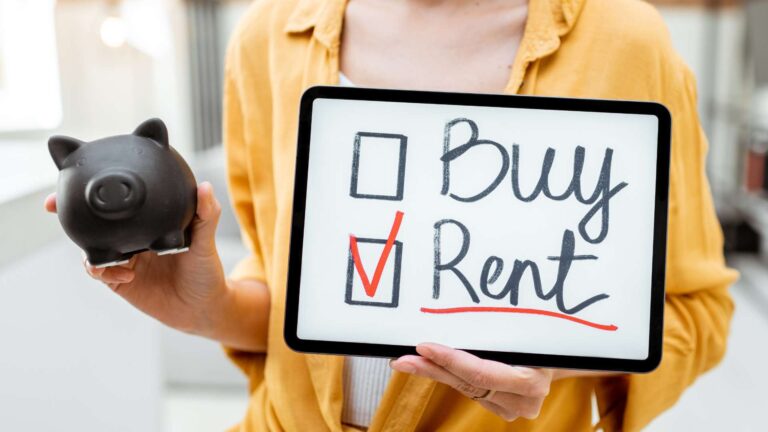Table of Contents
A Green Choice in 2025
As environmental concerns grow and sustainable living becomes more than just a trend, many individuals and families are rethinking how and where they live. Eco-friendly homes offer a path toward reducing your carbon footprint and lowering utility bills.. But when it comes to going green, one major question remains: Should you buy, build, or rent?
Each option has its benefits, challenges, and environmental impacts. Buying an existing green-certified home might offer convenience, while building your own allows for customization with the latest sustainable technologies. On the other hand, renting provides flexibility and lower upfront costs—ideal for those not ready to commit long-term.
This guide explores the pros and cons of each route, helping you decide which eco-friendly housing path aligns with your lifestyle, values, and financial goals.
The Case for Buying an Eco-Friendly Home
Buying an eco-friendly home that has already been built is often the most straightforward option. Developers and homeowners increasingly add sustainable features like solar panels, energy-efficient windows, green roofs, and EV charging stations.
Strengths of buying green:
- Immediate Impact: You immediately move into a sustainable space, cutting utility costs and your carbon footprint from day one.
- Predictable Costs: With features like solar, smart thermostats, and high-efficiency appliances already installed, you avoid expensive retrofits.
- Financing Incentives: Many states and banks offer green mortgage programs with lower rates or credits for homes meeting certain energy standards.
- Resale Value: Eco-friendly homes are in high demand. Buyers increasingly prioritize green certifications (like LEED or Energy Star), boosting long-term value.
Challenges of buying green:
- Premium Pricing: Eco-friendly homes often sell at a 5–10% premium compared to standard homes.
- Limited Inventory: In many markets, supply is low, meaning fewer choices.
- Inherited Design Choices: You may inherit eco-friendly features that are not optimized for your lifestyle—for example, a solar system sized for a larger family.
Buying is best for families who want stability, access to financing benefits, and immediate eco-conscious living without the complexities of construction.
Read related blog: Eco-Friendly Shopping: Sustainable Grocery Deals
The Case for Building an Eco-Friendly Home
For those with the vision and resources, building a green home from scratch delivers the ultimate control. You decide every material, layout, and system—ensuring the home aligns perfectly with your lifestyle and sustainability goals.
Strengths of building green:
- Total Customization: From solar orientation to recycled materials, you choose everything. Want a greywater recycling system? A rooftop garden? Passive solar heating? Building makes it possible.
- Future-Proofing: Building now allows you to integrate cutting-edge green technology that may not be common in older homes.
- Lower Long-Term Costs: A well-designed eco-home can slash utility bills by 50–70%. Some even reach “net-zero” status, producing as much energy as they consume.
- Health Benefits: Eco-friendly homes often use non-toxic paints, natural ventilation, and filtered air systems, reducing allergens and pollutants.
Challenges of building green:
- High Upfront Costs: Land purchase, permits, and custom design can easily exceed buying costs. Green materials (like bamboo flooring or triple-pane windows) often cost more upfront.
- Time-Consuming: Construction can take a year or more, with risks of cost overruns and delays.
- Specialized Expertise Needed: You need architects, contractors, and inspectors familiar with green standards. Not every builder is equipped for this.
Building green is ideal for families committed to long-term sustainability willing to invest for decades of savings and health benefits.
Read related blog: Eco-Friendly Shopping: Sustainable Electronics Deals
The Case for Renting an Eco-Friendly Home
Renting has traditionally been seen as the less “green” choice, but in today’s market, it offers surprising advantages. Many new apartment complexes and rental homes now feature eco-friendly amenities, such as solar-powered common areas, energy-efficient appliances, and LEED-certified construction.
Strengths of renting green:
- Low Barriers to Entry: No down payment, closing costs, or major construction budget required.
- Flexibility: Perfect for people in transition, digital nomads, or those testing green living before committing.
- Access to Amenities: Renters often enjoy shared eco-friendly features like EV chargers, community gardens, and bike storage that would be costly to install individually.
- Reduced Responsibility: Landlords handle maintenance, upgrades, and repairs. If the HVAC needs replacing, it’s not your financial headache.
Challenges of renting green:
- No Equity: Your rent doesn’t build wealth.
- Limited Control: You can’t always add features like solar panels or water-saving systems.
- Variable Utility Savings: Not all eco-friendly rentals are created equal. Some may boast “green branding” without meaningful energy savings.
Renting is best for those who value mobility, affordability, and access to eco-friendly features without the commitment of ownership.
Read related blog: Green Investing Guide: Build Wealth While Supporting a Sustainable Future
The Financial Comparison: Buy vs. Build vs. Rent
| Factor | Buy an Eco-Friendly Home | Build an Eco-Friendly Home | Rent an Eco-Friendly Home |
| Upfront Cost | High (premium price) | Very high (land + construction) | Low (deposit + rent) |
| Monthly Cost | Mortgage + utilities (lower due to efficiency) | Mortgage + utilities (lowest with net-zero design) | Rent + utilities (may vary by landlord) |
| Control | Moderate (retrofits possible) | Maximum (customization) | Low (limited tenant authority) |
| Equity Growth | Strong (resale premium possible) | Strong (unique eco-design boosts value) | None |
| Flexibility | Low (selling takes time) | Low (long-term commitment) | High (easy relocation) |
| Long-Term Savings | Strong (lower utilities + higher resale value) | Very strong (energy independence, long savings horizon) | Weak (no equity, savings depend on landlord’s design) |
Hidden Costs of Eco-Friendly Housing
Whether you buy, build, or rent, eco-living comes with hidden expenses that families must budget for:
- Technology Upkeep: Solar panels, smart thermostats, and water-recycling systems require maintenance and occasional replacement.
- Certification Costs: LEED or Energy Star certifications add fees to building and appraisal processes.
- Insurance Adjustments: Some insurers charge more for homes with green features, though others offer discounts.
- Market Premiums: “Green” branding may justify higher rents or listing prices, even if the efficiency is modest.
Environmental and Social Impact
Eco-friendly homes aren’t just about money; they’re about values. Green housing reduces carbon footprints, encourages sustainable development, and often fosters stronger community engagement (like urban gardens or shared renewable systems). However, eco-housing also raises questions of equity: Are green homes accessible only to wealthier buyers, or can renters and modest-income families also benefit?
The rise of government incentives, green building mandates, and broader adoption of energy efficiency suggests the eco-friendly path is becoming mainstream, not just a luxury.
Read related blog: Go Green and Save Money: How to Live a Green Lifestyle
When Buying Makes Sense
- You plan to stay at least 7–10 years.
- You can afford the premium price without being house-poor.
- You want long-term equity and value stability.
When Building Makes Sense
- You want full customization and control.
- You have capital to cover higher upfront costs.
- You plan to stay long enough (10–20+ years) to maximize returns.
When Renting Makes Sense
- You need flexibility (career moves, lifestyle changes).
- You don’t have savings for a down payment or land.
- You want access to green features without a long-term commitment.
How Beem Supports Eco-Friendly Living
Eco-friendly housing often means unexpected costs—higher deposits for green rentals, expensive retrofits, or surprise construction overruns. Beem’s Everdraft™ Instant Cash provides up to $1,000 with no interest, no credit checks, and no due dates, helping families manage transitions smoothly.
With smart budgeting tools and AI-driven financial planning, Beem ensures your green living goals don’t derail your financial stability. Download the app now!
The Bottom Line
In 2025, eco-friendly housing is no longer a niche; it’s a necessity. The decision to buy, build, or rent comes down to your financial readiness, lifestyle needs, and long-term goals. Buying offers stability and equity, building delivers customization and deep sustainability, while renting provides flexibility and affordability.
No matter which path you choose, pursuing eco-friendly housing isn’t ‘optional’. It’s an investment in your health, finances, and the planet’s future. The smartest choice is the one that balances sustainability with security and keeps your family’s future both green and stable.
FAQs on Eco-Friendly Homes: Buy, Build, or Rent?
Is it more expensive to buy an eco-friendly home in 2025?
Yes, eco-friendly homes often sell at a 5–10% premium compared to standard homes because of sustainable materials and advanced systems. However, lower utility bills, possible tax credits, and higher resale values usually offset this premium over time. The “green premium” is narrowing in many markets as more builders adopt eco-standards.
Does building a green home cost more than a traditional home?
Yes, upfront, eco-friendly construction can cost 10–20% more due to specialized materials and systems. However, these costs are usually recouped through reduced energy bills, lower water usage, and higher long-term property value. Building also lets you future-proof your home, making it cheaper to operate for decades.
Can renting an eco-friendly apartment really save money?
It depends. Some eco-friendly rentals include energy-efficient appliances, solar, or insulation upgrades that lower monthly utility costs. However, rents may be slightly higher because landlords pass on the cost of green construction. The savings can be even more significant if the utilities are included in rent.
What government incentives exist for eco-friendly homes?
In 2025, many federal and state programs still offer tax credits, rebates, or lower-rate financing for eco-friendly housing. These can apply to solar panels, energy-efficient appliances, and even green-certified homes. Renters may not access these incentives directly, but landlords often pass down savings through stable utility costs.
Which is better for long-term wealth: buying, building, or renting green?
Buying or building typically delivers stronger long-term wealth through equity and appreciation. Renting offers no direct wealth-building, but renters can still invest their savings in retirement accounts or stocks. The “better” choice depends on whether you prioritize liquidity and flexibility (renting) or equity and stability (buying/building).














































